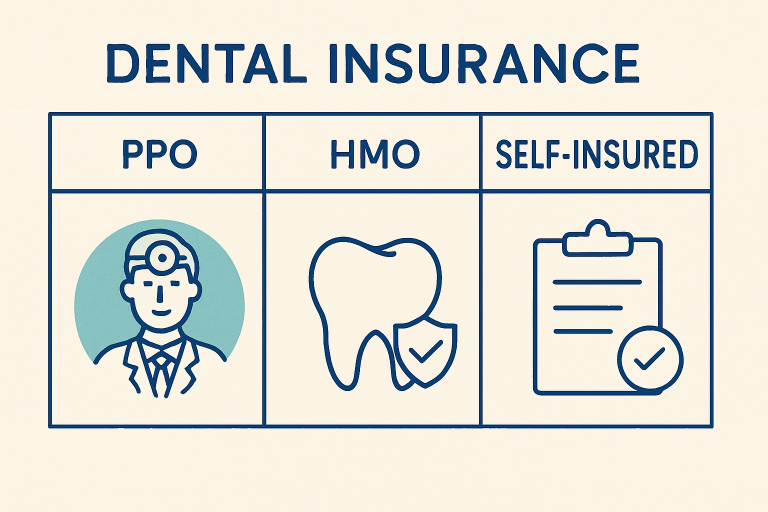Key Takeaways
- Understanding the different types of dental insurance plans helps you make informed decisions.
- Evaluating coverage options and limits ensures the plan meets employees’ needs.
- Assessing the network of dental providers affects accessibility and satisfaction.
- Considering preventive care coverage can lead to long-term health benefits and cost savings.
- Flexibility and portability of the plan are important for accommodating diverse employee situations.
Table of Contents
- Types of Dental Insurance Plans
- Assessing Coverage Options and Limits
- Evaluating Network of Dental Providers
- Importance of Preventive Care Coverage
- Considering Flexibility and Portability
Introduction
Providing comprehensive dental insurance is a strategic move for employers looking to support the health and satisfaction of their workforce. With a multitude of plans available, selecting the right coverage can be a challenging task. To make an informed decision, it’s essential to compare dental insurance with Delta Dental and similar providers that offer a range of plans suited to different organizational needs. By understanding the details of various plans, employers are better equipped to enhance employee well-being, foster loyalty, and even drive productivity.
This guide equips HR managers, benefits coordinators, and business leaders with a clear framework for evaluating dental insurance plans, ensuring the optimal balance of coverage, flexibility, and cost efficiency for any team.
Types of Dental Insurance Plans
The foundation of a smart benefits strategy is understanding the primary types of dental insurance available. Each comes with its own advantages and potential drawbacks, making it essential to match the plan type to the unique profile of your organization’s workforce.
- Preferred Provider Organization (PPO): PPO dental insurance plans offer employees the flexibility to visit any licensed dentist, but provide the greatest savings when members use dentists within an established network. PPOs are a popular choice for companies that value both provider choice and cost savings, giving employees control over their oral healthcare decisions while often reducing out-of-pocket expenses for in-network care.
- Health Maintenance Organization (HMO): HMOs typically offer lower premiums and more predictable costs in exchange for a more restricted provider network. Employees must select a primary dentist and normally receive coverage only for in-network treatment. For organizations managing tight budgets or those with a workforce that favors simplicity and lower costs, an HMO can be an ideal solution.
- Self-Insured Plans: Larger organizations may opt to self-insure their dental coverage, assuming direct responsibility for employees’ dental claims. This approach can reduce administrative costs and provide greater flexibility, but also transfers financial risk to the business. A robust risk management strategy is crucial before proceeding with this option.
Assessing Coverage Options and Limits
Reviewing the breadth and depth of coverage a plan provides is crucial. While some plans offer basic coverage for preventive and restorative services, others include more comprehensive options for major dental work.
- Preventive Care: Comprehensive plans should cover preventive care—such as exams, cleanings, and x-rays—at 100%. Knowing how often services like cleanings or fluoride treatments are allowed per year is crucial in encouraging regular dental visits and preventing more severe health issues.
- Basic and Major Services: Basic services include fillings, simple extractions, and emergency treatments. Major services encompass more complex procedures, such as crowns, bridges, dentures, and oral surgery. The percentage covered by insurance often declines as procedures become more extensive, so employers should ensure the plan aligns with anticipated employee needs.
- Deductibles and Co-pays: Deductibles are the annual amounts employees must pay out-of-pocket before insurance benefits kick in. Co-pays are flat fees for specific services or a percentage of the cost. Lower thresholds translate to higher premiums, but provide cost predictability for employees and their families.
Evaluating Network of Dental Providers
A strong provider network can significantly enhance employee satisfaction and ease of access to care. It also helps control costs for both employers and employees.
- In-Network Savings: Visiting in-network dentists can deliver substantial savings—sometimes 20% to 50%—on procedures, thanks to prenegotiated rates. Plans with large, geographically diverse networks minimize disruptions for employees and facilitate seamless onboarding across multiple locations.
- Out-of-Network Costs: Although some plans reimburse for out-of-network services, employees typically face higher costs for care obtained outside the network. These expenses can be particularly steep for major procedures, with higher deductibles and co-insurance, so evaluating the plan’s approach here is essential.
Importance of Preventive Care Coverage
Preventive care is a fundamental and essential cornerstone in reducing long-term healthcare costs and improving overall health outcomes. According to Cigna Healthcare’s comprehensive national study, employees who consistently utilize preventive dental benefits tend to experience significantly fewer major dental procedures, notably lower medical costs across various health sectors, and fewer hospitalizations, which collectively contribute to healthier, more productive workforces. This compelling evidence highlights that robust preventive care coverage is not just a beneficial add-on but a critical component that should be a must-have for employers. Such coverage supports both immediate health needs and long-term wellness initiatives within their teams, ultimately fostering a healthier, more resilient, and more engaged employee base.
Final Thoughts
Selecting the best dental insurance plan involves a comprehensive process that requires carefully evaluating a variety of organizational needs, considering employee preferences, and thoroughly understanding the unique features and benefits of each different plan type available in the market. Employers who are willing to dedicate the necessary time and effort to compare and analyze various features—such as provider networks, coverage options, preventive care offerings, flexibility, out-of-pocket costs, and coverage limits—are more likely to make informed decisions. Ultimately, this proactive approach fosters not only the health and well-being of employees but also enhances employee loyalty, job satisfaction, and overall happiness, contributing to a more productive and positive workplace environment.
READ ALSO: Game Saver: Your Essential Sports First Aid Kit Guide

